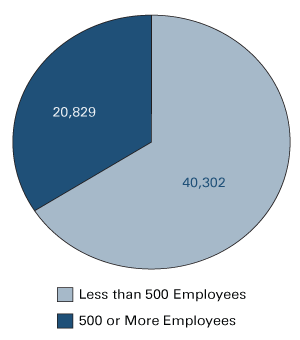Embracing Entrepreneurship
Assistant Professor of Management, Ball State University
Which public policies are most effective at enhancing economic performance? On two occasions in the past six months, I have presented research findings on this topic to members of the Indiana General Assembly. I made two interesting observations during these meetings.
First, there is an apparent translation problem between the quality of our top entrepreneurship programs and the actual creation of new employment-generating ventures in the state. For example, entrepreneurship programs at Ball State University and Indiana University both rank in the top 10 of all entrepreneurship programs nationally, but according to a study funded by the Kaufmann Foundation, Indiana ranks 44th nationally in the percent of employment accounted for by young firms.1
Second, I observe a disconnect between, on the one hand, the recognition of entrepreneurship's importance to Indiana, and on the other hand, the lack of knowledge regarding what to do to create an entrepreneurial economy. There is significant uncertainty exhibited among our elected leaders regarding what they should be doing to grow the economy through increasing entrepreneurial activity.
What the Research Shows
Scholars, public officials, successful entrepreneurs and financiers must come together to rapidly devise and implement effective strategies to take Indiana from its agrarian and industrial past to its entrepreneurial and globally competitive future. Empirical research strongly suggests that the old economic models and economic development strategies are not the answer.2 We need to question the wisdom of chasing after mature and declining industries through traditional strategies, which often represent a race to the bottom among states who give away the store in the form of foregone tax revenues in order to secure visible "wins." These short-sighted strategies include temporarily delaying a plant's closure or claiming large job creation numbers at low-skilled, labor-intensive call centers, distribution centers, service providers and big-box retail shops.
A better focus would be on maximizing the contribution of small, fast-growing and relatively young businesses. According to the Statistics of U.S. Businesses, about 90 percent of employers nationally have fewer than 20 employees.3 In 2007, 85 percent of all Indiana businesses were micro businesses (fewer than 20 employees) and employed approximately one out of every five workers in the state.4 Importantly, high-growth small businesses are the types that provide the greatest percentage of net new jobs.5 Between 1994 and 2006, U.S. firms with fewer than 20 employees represented approximately 94 percent of all high-impact firms (those with high employment and high revenue growth) and accounted for approximately one-third of job growth among all high-impact firms. As seen in Figure 1, small businesses in Indiana created nearly double the number of net new jobs created by large businesses, according to the most recent data available.
Figure 1: Net Jobs Created in Indiana by Firm Size, 2005 to 2006

Source: U.S. Small Business Administration Office of Advocacy
According to U.S. Department of Commerce data, firms with greater than 500 employees have been contracting, resulting in net job losses year to year over the last decade, while firms with fewer than 500 employees have been consistent in creating net new jobs over the same time period.7 Yet in the media, we typically only hear about large corporations bringing jobs, while small firms lack recognition for their role in overall job creation. Net employment losses are not just due to employment contractions among existing, mature firms; a lack of expansion among younger firms in particular is thought to be just as important of a factor.8
Public policy follows this tendency to reward the large, mature corporations while ignoring the smaller, faster-growing businesses, despite the latter being significantly more effective in providing new employment opportunities. Prototypical tax credits do not provide incentives for new firm creation. Start-ups do not normally have taxable income for their first several years, so providing credits and deductions to offset corporate income tax is an ineffective way to stimulate the creation and initial growth of new ventures. Politicians may feel pressure from their constituents to support what is tried and true and visible—even though the strategy represents a losing hand in the economic development game. On average, low-impact firms do not grow at all, and nearly all job loss in the economy from 1994 to 2006 has been attributed to low-impact firms with greater than 500 employees.9 Public officials should focus on providing grants for and equity investments in promising small and emerging enterprises, as well as providing regulatory relief and regulatory stability, which would remove serious obstacles to the establishment and growth of new job-generating businesses.
Research confirms that through finding new market opportunities and commercializing innovation, entrepreneurs play a central, critical role in job creation, productivity growth and economic prosperity.10 Smaller and younger companies generate systematically higher growth rates relative to their older, larger counterparts. Regional economic performance is linked to how well public investment in new knowledge translates into innovative activity in the marketplace. Entrepreneurship is the vehicle by which the most important ideas are implemented and commercialized, representing the missing link between investments in education, research and development, and economic growth.11
Innovative risk takers are likely to become serial entrepreneurs, reinvesting the gains from their initial business in successive employment-generating enterprises. Entrepreneurs themselves are central to economic growth, accounting for one-third of the difference in economic growth rates among countries.12 Areas with greater entrepreneurial capital in the form of regional institutions, professionals, and fluid and decentralized networks produce higher economic output.13 Greater competition and diversity among a large number of small, innovative enterprises itself positively impacts economic growth.14 Wealth is positively affected as well, since the earnings of entrepreneurs with incorporated businesses are nearly double that of the earnings of wage and salaried workers in established firms.15 Small entrepreneurial firms are the fastest growing segment of exporting firms and thus are also important for addressing the trade deficit.16
The results from these research findings suggest that Indiana should focus on growing its own firms as a high-growth economic development strategy. States that succeed in the new economy differentiate themselves by explicitly meeting the specific needs of aspiring and emerging entrepreneurs and by making entrepreneurial firms central to its economic development strategy.17 Policy-makers should target those industries most conducive to new firm creation, which research shows have lower start-up costs, fewer barriers to new firm entry and higher levels of technological change.18 In addition, policy-makers can assist by fostering supportive networks and allocating resources for nascent, emerging and serial entrepreneurs.
A consensus among academics and public officials is forming that new ventures with high revenue growth or so-called "gazelles" deliver the greatest return on public investment.19 Firms with both high revenue growth and rapid employment expansion, or so-called "high-impact firms" are especially critical, and in fact contribute to the majority of overall economic growth and almost all growth in private sector employment.20 Our leaders can promote high-impact entrepreneurial activity by encouraging risk taking, providing legal protection and seed capital, and encouraging heavy investment in human capital, research and development, and knowledge creation.
What Entrepreneurs Need Most
Policy-makers can stimulate economic growth and job creation by making improvements to the three things entrepreneurs need to commercialize an opportunity: skills, resources and networks. Indiana can give its innovative and creative citizens and new immigrants to Indiana the greatest chance of success by creating and nourishing networks, fostering partnerships among local and regional governments and educational institutions, and by developing the necessary technical and managerial skills in the population.
Entrepreneurs need assistance in creating solid business plans and with accessing and developing managerial talent. Policy-makers can improve the skills of individual entrepreneurs by investing in entrepreneurial education and providing training through one-stop shops, business development centers and incubators. Curriculum that fosters risk taking, innovation, creativity, and technological and managerial prowess can be designed from elementary through graduate school.
The best entrepreneurial education will be hands-on, immersive and experiential, and will connect active participants with existing firms, entrepreneurs and professional service providers such as lawyers, accountants and marketing executives; as well as supportive and resourceful investors. High schools, community colleges, teaching universities and small business development centers can play a more active role in delivering the skill sets and providing direction for those considering business ownership, while entrepreneurship centers at research universities can deliver the next generation brain- power and unleash the creativity and management skills necessary to deliver more promising high-impact gazelles.
Policy-makers can strengthen both networks and community resources by pooling funds and providing better access to technology as well as information and guidance on starting, running, growing, funding and managing a business. Local governments can provide critical information to aspiring entrepreneurs. Rural and small town entrepreneurs in particular face serious challenges in establishing the requisite networks and support systems, including finding the right financiers, lawyers, accountants and business partners.21
Policy-makers can play an active role in transitioning Indiana to the 21st century global economy by fostering strategic relationships and vibrant networks among research intensive universities, corporations and entrepreneurial agents such as scientists, engineers, financiers and inventors across the globe. In addition, policy-makers might consider actively funding and promoting research parks, incubators, public-private partnerships, immersive learning and collaborative development projects to foster the expansion of and returns to these networks.
In Short
Through creating stronger linkages among state universities, research institutions and the global business sector, and by shifting the culture away from developing job retention employment skills for mature and dying sectors to one that develops the skills necessary to build new high-growth businesses, Indiana leaders can create a rich climate conducive to the birth, attraction and retention of innovative entrepreneurial firms that create new products and services and expand into new markets.
Stimulating intelligent risk taking, creativity and innovation is good public policy. A failed start-up is not a net loss to society; those involved with the start-up venture, including the founders, venture capitalists, lenders and other competing businesses learn from attempts to launch a new technology or take a new idea to market. Later attempts by serial entrepreneurs may just launch the next Google, Facebook, Intel or Microsoft, which would be a boon to the Indiana economy for years to come.
Notes
- John C. Haltiwanger, Ron S. Jarmin and Javier Miranda, "Business Dynamics Statistics Briefing: Entrepreneurship across States," February 1, 2009.
- David B. Audretsch, Max C. Keilbach and Erik E. Lehmann, Entrepreneurship and Economic Growth (Oxford: Oxford University Press, 2006).
- Based on 2006 data.
- Molly Manns, "Indiana's Small Business Snapshot," InContext, March-April 2010, www.incontext.indiana.edu/2010/mar-apr/article2.asp.
- Brian Headd, "An Analysis of Small Business and Jobs," U.S. Small Business Administration, Office of Advocacy, March 2010.
- Zoltan Acs, William Parsons and Spencer Tracy, "High-Impact Firms: Gazelles Revisited," U.S. Small Business Administration Publication No. 328, June 2008.
- Based on U.S. Department of Commerce, Census Bureau, and Statistics of U.S. Businesses data on nonfarm establishment job gains and losses for Indiana by firm size. These statistics are presented in the annual publications of the U.S. Small Business Administration's Office of Advocacy and can be accessed at www.sba.gov/advocacy.
- See note 5.
- See note 6.
- Martin A.Caree and A. Roy Thurik, "The Impact of Entrepreneurship on Economic Growth," in The Handbook of Entrepreneurship Research, International Handbook Series on Entrepreneurship, 2010, Volume 5, Part 6, 557–594.
- See endnote 6, page 51 and Acs, Audretsch and Strom, Entrepreneurship, Growth, and Public Policy (New York: Cambridge University Press, 2009).
- Paul D. Reynolds, Michael Hay and S. Michael Camp, "Global Entrepreneurship Monitor's Executive Summary 2000," 20.
- See note 2.
- See note 2.
- Jay Henderson, "Building the Rural Economy with High-Growth Entrepreneurs," Economic Review 3Q (2002), 45–70.
- See note 15.
- Jay Kayne, "State Entrepreneurship Policies and Programs," Kaufmann Center for Entrepreneurial Leadership, November 1, 1999.
- See notes 2 and 15.
- This term describes the high-growth, job generating new venture and is attributed to David Birch in The Job Generation Process published in 1979.
- See note 6.
- See note 15.
Also in this Issue…




